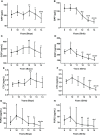The Effect of BMI, Age, Gender, and Pubertal Stage on Bone Turnover Markers in Chinese Children and Adolescents
- PMID: 35769079
- PMCID: PMC9234688
- DOI: 10.3389/fendo.2022.880418
The Effect of BMI, Age, Gender, and Pubertal Stage on Bone Turnover Markers in Chinese Children and Adolescents
Abstract
Objectives: To ascertain the associations of serum bone turnover markers (BTMs) levels with body mass index (BMI) in Chinese children and adolescents, and whether the influence of BMI, age, pubertal stage on BTMs varied by gender.
Methods: A total of 500 students (180 controls and 320 children and adolescents with overweight/obesity) aged 9-14 years were randomly selected from the Chinese National Survey on Students Constitution and Health Cohort. Serum levels of BTMs, including bone formation marker bone alkaline phosphatase (BAP), collagen type 1 C-terminal propeptide (CICP), and bone resorption markers C-terminal telopeptide of type-I collagen (CTX) were determined by commercial enzyme-linked immunosorbent assay kits. The associations among BMI, age, gender, pubertal stage, and BTMs were analyzed.
Results: Serum levels of CICP and CTX in overweight/obese children and adolescents were lower than those in controls (p<0.05). Moreover, after subgroup analysis stratified by gender, the decreased serum CICP and CTX levels in overweight/obese children and adolescents were observed only in boys (p<0.05). After adjustment of age and pubertal stage, there was a negative correlation between serum BAP and BMI in both boys and girls (p<0.05). However, the correlations between serum CICP, CTX levels, and BMI were significant in boys but not in girls. Serum BAP and CICP levels were independently correlated with BMI, age, gender, and pubertal stage, while CTX levels were independently correlated with BMI, age, and gender (p<0.05). BAP, CICP, and CTX levels showed a clear age, gender, and pubertal stage dependence with significantly higher values in boys (p<0.05).
Conclusions: Our findings support the associations between serum BTMs levels and BMI in Chinese children and adolescents, and suggest age, gender, and pubertal stage differences in this relationship that warrant future studies.
Keywords: age; body mass index (BMI); bone turnover markers (BTMs); children; gender; pubertal stage.
Copyright © 2022 Cao, Liu, Luo, Wang, Liu, Liang, Wu, Li, Su, Chen and Gong.
Conflict of interest statement
The authors declare that the research was conducted in the absence of any commercial or financial relationships that could be construed as a potential conflict of interest.
Figures



Similar articles
-
Abnormal Bone Turnover Observed in Obese Children based on Puberty Stage-Specific Bone Turnover Marker Reference.J Clin Endocrinol Metab. 2024 Sep 16;109(10):2478-2490. doi: 10.1210/clinem/dgae206. J Clin Endocrinol Metab. 2024. PMID: 38557870
-
Children and adolescents with obesity have reduced serum bone turnover markers and 25-hydroxyvitamin D but increased parathyroid hormone concentrations - Results derived from new pediatric reference ranges.Bone. 2020 Mar;132:115124. doi: 10.1016/j.bone.2019.115124. Epub 2019 Dec 9. Bone. 2020. PMID: 31830529
-
Reference intervals for serum concentrations of three bone turnover markers for men and women.Bone. 2013 Dec;57(2):399-404. doi: 10.1016/j.bone.2013.09.010. Epub 2013 Sep 27. Bone. 2013. PMID: 24076251
-
Broad application prospects of bone turnover markers in pediatrics.J Clin Lab Anal. 2022 Sep;36(9):e24656. doi: 10.1002/jcla.24656. Epub 2022 Aug 10. J Clin Lab Anal. 2022. PMID: 35949006 Free PMC article. Review.
-
Bone Turnover Markers in Children: From Laboratory Challenges to Clinical Interpretation.Calcif Tissue Int. 2023 Feb;112(2):218-232. doi: 10.1007/s00223-022-00964-2. Epub 2022 Mar 4. Calcif Tissue Int. 2023. PMID: 35243530 Review.
Cited by
-
Metabolismo óseo en niños aragoneses con normopeso y niños con sobrepeso/obesidad.Adv Lab Med. 2024 Jan 1;5(1):75-84. doi: 10.1515/almed-2023-0065. eCollection 2024 Mar. Adv Lab Med. 2024. PMID: 38634080 Free PMC article. Spanish.
-
Genome-wide association study of blood vitamin D metabolites and bone remodelling markers in pigs.BMC Genomics. 2025 Aug 2;26(1):718. doi: 10.1186/s12864-025-11914-1. BMC Genomics. 2025. PMID: 40753194 Free PMC article.
-
Bone metabolism in children with normal weight and overweight/obesity in a northeastern region of Spain.Adv Lab Med. 2024 Mar 8;5(1):66-74. doi: 10.1515/almed-2024-0026. eCollection 2024 Mar. Adv Lab Med. 2024. PMID: 38634087 Free PMC article.
-
The inverse relationship between fatness and bone mineral content is mediated by the adolescent appendicular skeletal muscle mass index: The Cogni-Action Project.Front Nutr. 2022 Nov 15;9:1040116. doi: 10.3389/fnut.2022.1040116. eCollection 2022. Front Nutr. 2022. PMID: 36458170 Free PMC article.
-
Bone-Specific Alkaline Phosphatase as a Complementary Diagnostic Marker for the Assessment of Children and Adolescents with Secondary Osteoporosis.Diagnostics (Basel). 2025 Mar 5;15(5):630. doi: 10.3390/diagnostics15050630. Diagnostics (Basel). 2025. PMID: 40075877 Free PMC article.
References
-
- The Collaborative Initiatives at MIT. The Urban Design Lab at the Earth Institute at Columbia University . Food and Health: Using the Foodsystem to Challenge Childhood Obesity (2009). Available at: https://collaborative.mit.edu/sites/default/files/projects/ObesityFoodHe....
Publication types
MeSH terms
Substances
LinkOut - more resources
Full Text Sources
Medical

